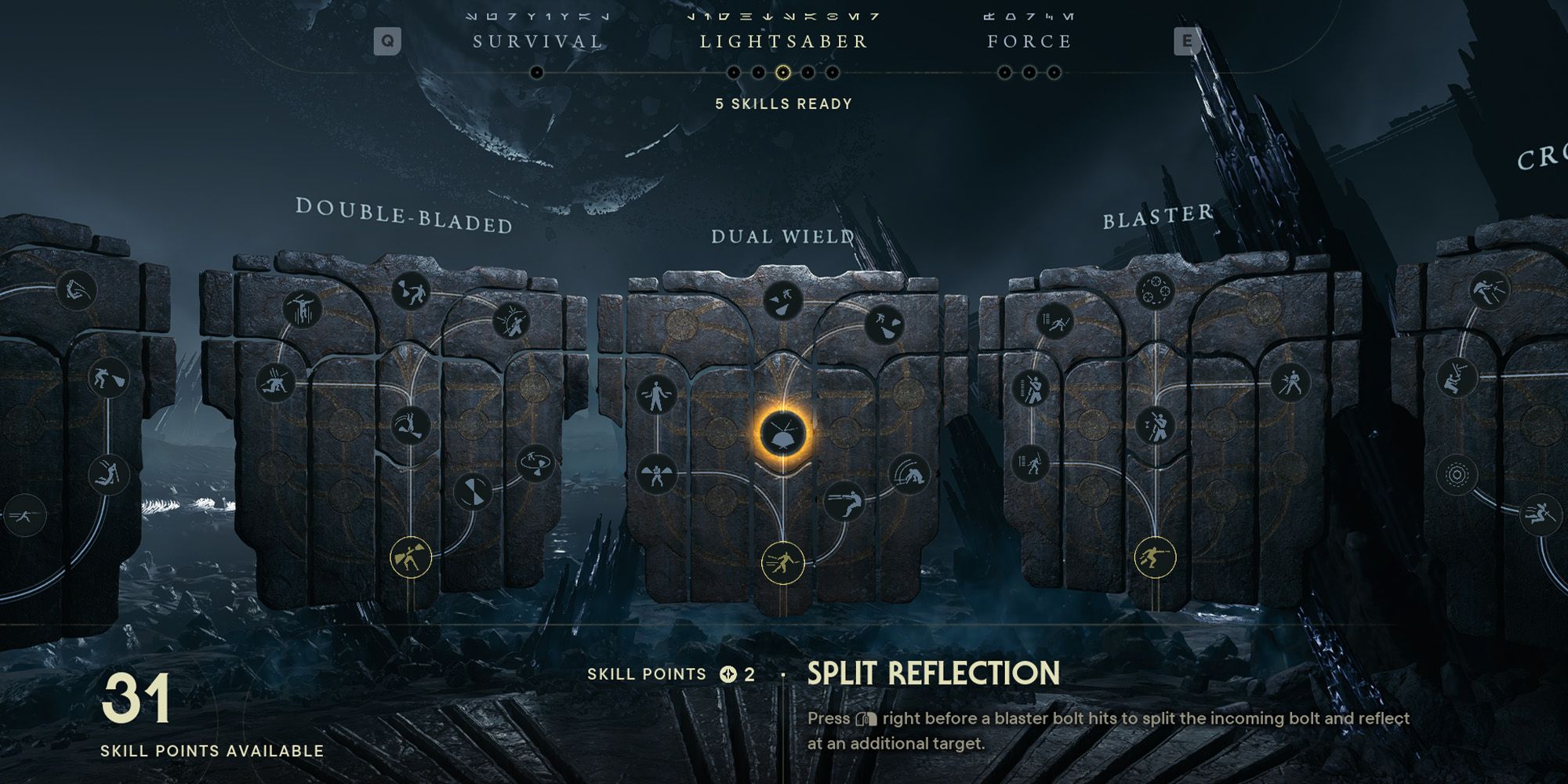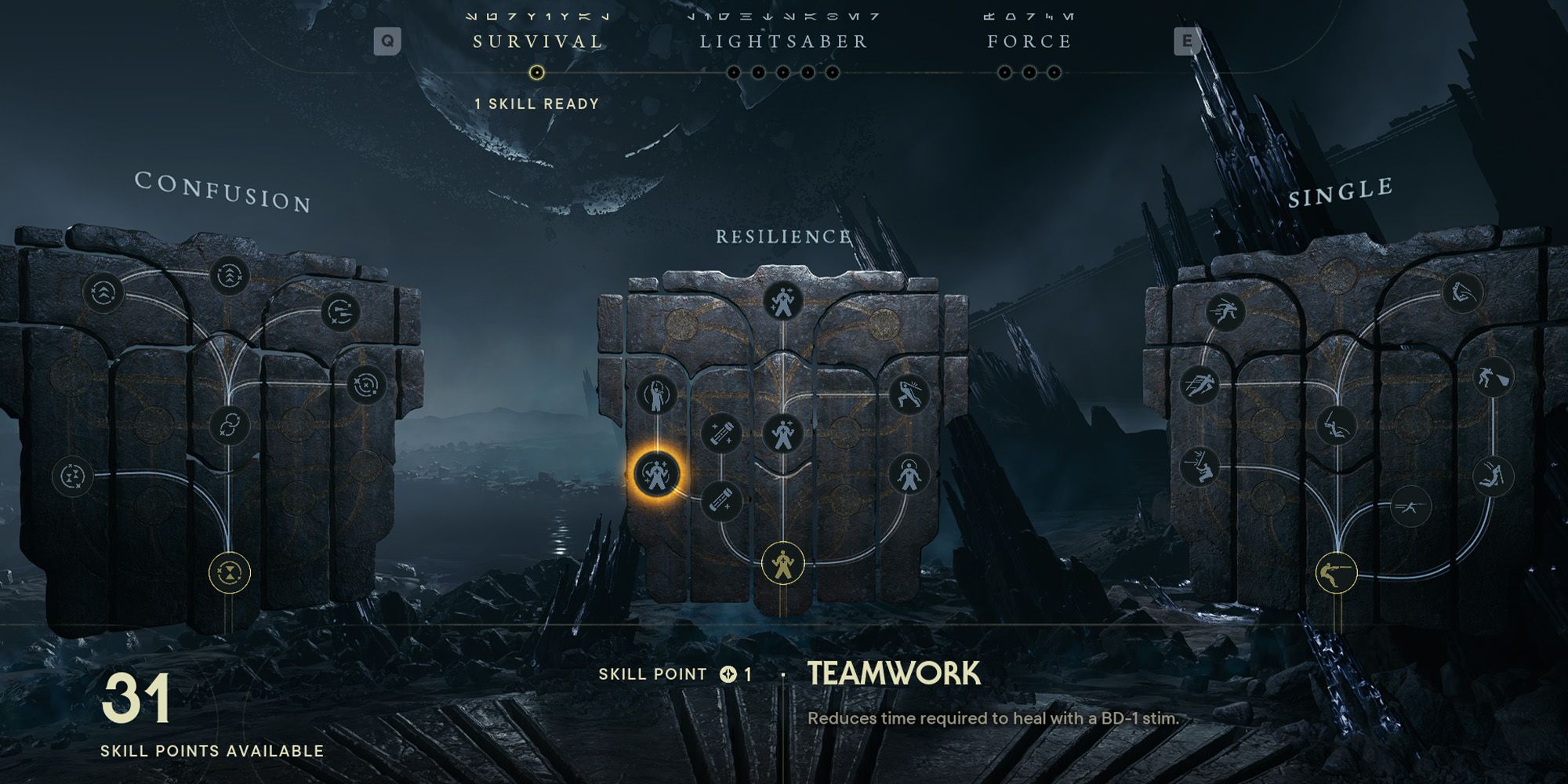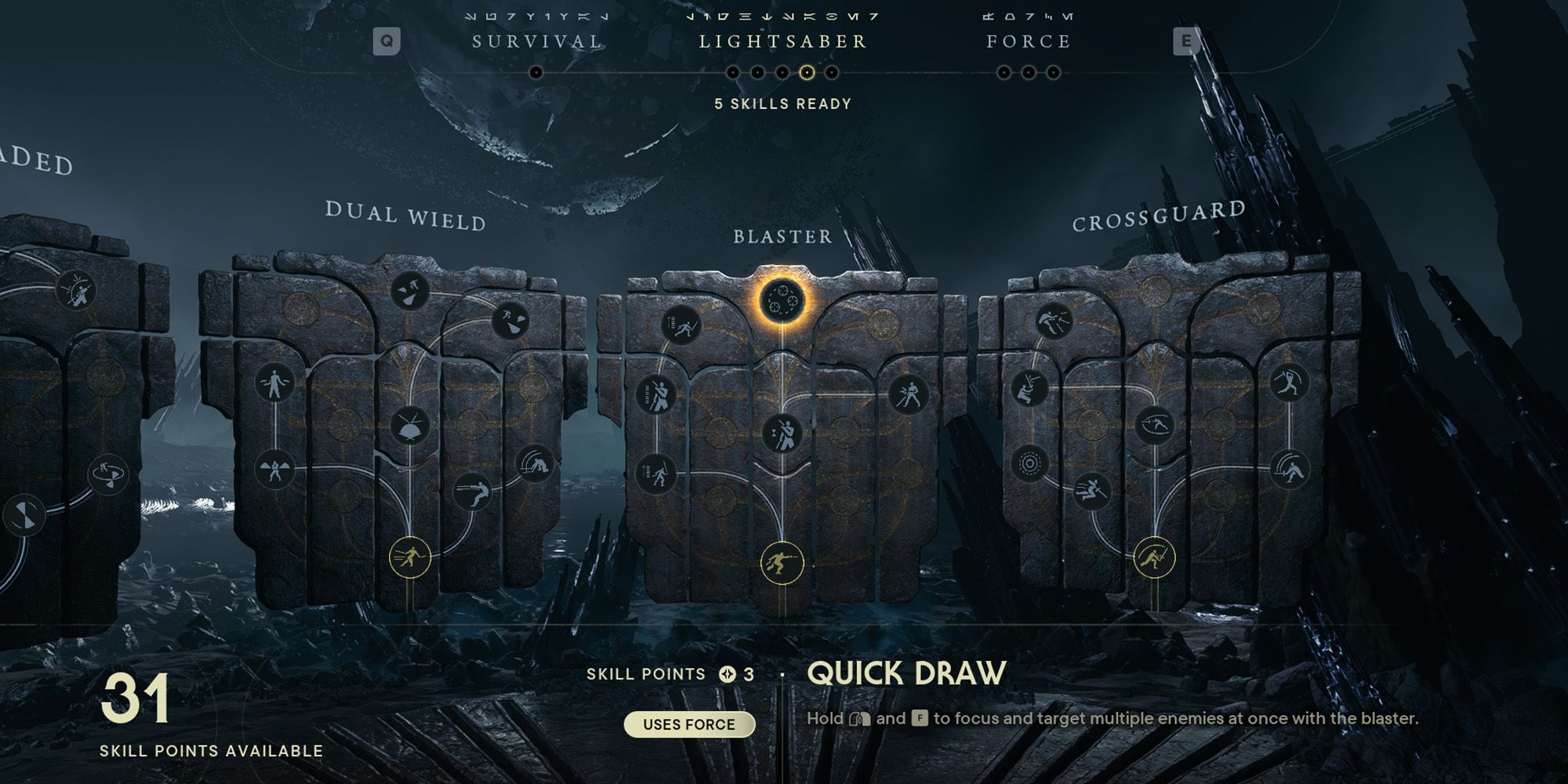Picking the right skills in Star Wars Jedi: Survivor can seem a bit difficult for newcomers. At the beginning of the game, players are given many skills to choose from to enhance and customize their character, but committing to spending hard-earned skill points before knowing which playstyle they are going to enjoy can be frustrating.
Thankfully, there is a way to refund skill points, the first one is free, but subsequent resets come at the cost of losing a skill point. It would have been a nice feature to have the complete freedom to adjust skills, along with your best stance of choice, to be able to fully test every playstyle to see which one works best for you. Fortunately, there doesn’t seem to be a limit to the number of skill points a player can earn and allocate, but the initial selection can still feel daunting.
Getting better at combat largely comes down to knowing when to time attacking and defending properly, but choosing the right skills is also an important factor. Here are the top picks for early-game skills that players should consider when starting a new character.
Best Lightsaber Skills In Jedi Survivor

Players should invest in the Lightsaber Skills first as the majority of combat will be completed using a blade. Focusing points on getting one of these two skills first is a priority:
- Twofold Reflection for the Single Blade Stance, and/or
- Split Reflection for the Dual Wield Stance.
They both offer extra blaster parrying capabilities and aren’t don’t require many points to be spent in each of the skill trees. After these, players should choose a stance they prefer and go deeper into that tree.
Don’t save skill points for the locked skill trees, Blaster and Crossguard, as there are useful skills that are available right away. More on that at the end of the post.
Single Blade Skills
The Single Blade Stance is a great versatile all-around stance for most types of combat. While they all require selecting the very slow Lunging Strike skill, there are great opportunities that open up for a variety of combat styles.
- Twofold Reflection: This is a fantastic skill to select early on as it can double the amount of parried blaster projectiles sent back. Something that will be happening very often.
- Dash Strike: This is a fantastic gap closer to get closer to enemies while also dealing good damage.
- Aerial Dash Strike: Upgrades the previous skill to be able to hit airborne targets. While there are not very many, the few that do exist can be difficult to take out.
- Charged Throw: This makes the thrown lightsaber even stronger. Requires better timing, but worth the risk if successful.
Double-Bladed Skills
The Double-Bladed Stance isn’t as versatile as some of the others. The only skill that would be recommended is the Multifold Reflections skill, but it is deep within the skill tree. It greatly enhances the exceptional blaster projectile parrying capabilities of this stance. Melee combat in this stance revolves around hitting multiple closely grouped enemies. Lining up enemies, however, is a more cumbersome task and is generally more effort than other stances.
There are two problems with the two ranged skills available, Double Orbit and Controlled Throw, they are deeper in the skill tree and when used, come at a great risk of being left defenseless without a lightsaber to guard yourself.
Dual Wield Skills
Both of these skills require the first skill, Backstep Slash, skill to be unlocked first; it is a strong melee skill that uses force and helps distance yourself from the target.
- Split Reflection: Upon successfully parrying a blaster bolt, two projectiles are launched instead of one, doubling the amount of damage dealt. This is a very powerful skill that will be used countless times as there is no shortage of blaster attacks in Star Wars Jedi: Survivor.
- Twin Vipers: Able to throw a second blade right after the first. This is particularly useful when there are multiple ranged targets or when keeping your distance from a powerful enemy or boss that you’d rather not get too close to.
After picking up these skills, the final skill, Dancing Blades, provides significant ranged damage to clear a lot of targets. The caveat is that with a long wind-up animation and both blades being away from Cal, the player is left defenseless momentarily. It’s still very strong and worthwhile if it can be used correctly.
Best Force Skills In Jedi Survivor
The Force skills are great secondary tools to help control the battlefield. Consider taking these after picking up the Lightsaber Stance Skills of your choice.
Telekineses Skills
Note that we will update this guide to include the remaining Telekineses Skills that are locked.
- Wrenching Pull: Helps to interrupt nearby enemies and bring them together for a powerful followup to hit multiple enemies.
- Twin Pull: Is a great way to control two enemies at a time or to quickly dispatch them off of cliffs.
- Unrelenting Pull: While expensive is very advantageous for large enemies or bosses, such as the Rancor, that can be difficult to take down with a lightsaber alone.
Jedi Concentration Skills
The upgrades in Jedi Concentration are not particularly interesting as Max Force is upgraded naturally through hidden treasures and the Slow ability has limited effectiveness.
Confusion Skills
The Mind-Control ability is a fun tool that should be used as often as possible. All the Skills in the Confusion Tree help make the mind-control ability stronger. However, because mind-control does not work on any droids, it greatly limits the power of these upgrades throughout the game.
Best Survival Skills In Jedi Survivor
Points spent here are not very strong early on as both Stim and Health upgrades are discovered with hidden treasures in various locations throughout the game. This should be one of the last options that players should choose.
Resilience Skills

- Teamwork: This is one of the only skills that should be taken into consideration early on if there are extra points that can be spent. The time required to heal from BD-1 can be frustrating in certain circumstances, so this one skill has the potential to be life-saving.
Blaster and Crossguard Skills
By the time the Blaster and Crossguard Stances become unlocked, players should have a decent understanding of the game, their opponents, and combat mechanics to make a good decision. If you’re still wary, take a look at our recommendations.
Blaster Skills

If you’re going for the Blaster Stance, all of the skills greatly improve the overall function of the stance. The final skill, Quick Draw, is a very powerful multi-target ability that deals massive damage.
Crossguard Skills
For the Crossguard Stance, again, many of the skills here lean into the powerful nature of the stance. Grab the skill Greater Cleaving Swing for a faster charge attack, and pick up Charged Reflection for a more powerful blaster parry attack. Two other skills, Rolling Thunder and Greater Impact also give the stance more ranged capabilities.
That wraps it up for the best skills in Star Wars Jedi: Survivor, hopefully, this information has provided a better understanding of the skills available. Players shouldn’t worry about making too many mistakes as, again, the first full skill reset is free, and subsequent ones only cost 1 skill point. While these guidelines were written with the intention of improving the early stages of gameplay, the stance that players choose is a personal one but there are some key differences between them that players should read about or experiment on their own.


